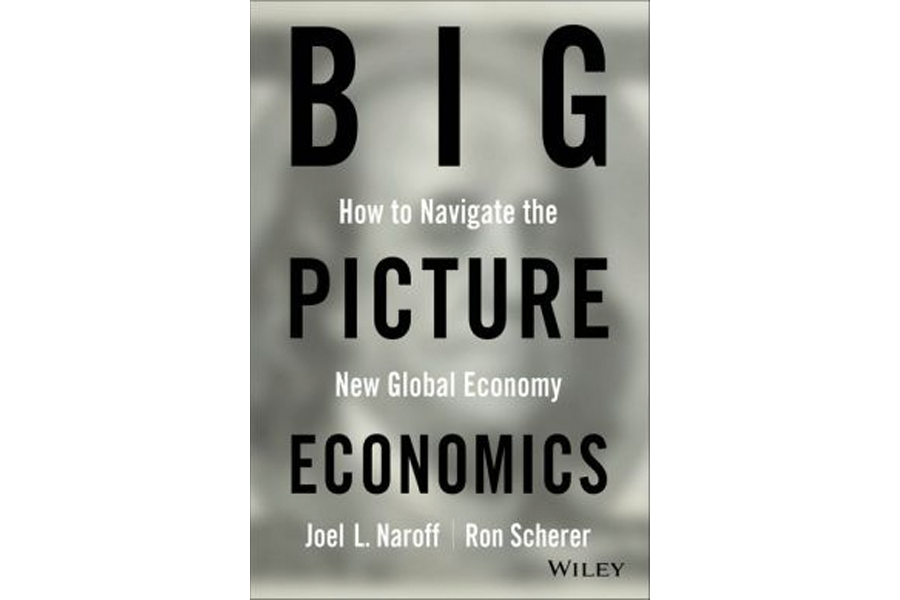'Big Picture Economics' cuts through the jargon and complexity of the American economy
Loading...
The Great Recession of 2008 was not kind to economists, many of whom failed to predict the housing meltdown and have spent the past few years locking horns over government stimulus spending and quantitative easing. But that backlash has also fueled a public appetite for books that can explain the art of economic prediction and why economists have so often been wrong.
“Economists are seen as having been put on this earth to make weather forecasters look good,” authors Joel Naroff, an economist, and Ron Scherer, a former Monitor correspondent, quip toward the opening of Big Picture Economics. This is a book that seeks to bring some common-sense thinking to the debate as to why government economic policies so often seem to go awry. Naroff and Scherer offer a simple mantra to cut through the jargon and complexity: Economic policy is all about context. Are tax cuts good or bad? How about deficit spending? The answer to all economic questions, the authors say, is “It depends.”
Naroff and Scherer aren’t interested in wading into political or ideological battles. For much of the book, context means the timing of the business cycle. For example, a red-hot stock market coupled with rising housing prices might seem like a good news story today. But back in 2006, that kind of growth turned out to be a sign of impending trouble.
Slashing taxes during an economic downturn is a politically popular move, but the authors argue that does nothing to help spur economic growth during a recession since consumers aren’t likely to start spending that new money if they’re worried about keeping their jobs, houses, or retirement portfolios. By the same token, businesses aren’t likely to go on a hiring spree if they’re not sure they can last the year. The best time to implement tax breaks, they argue, is when the economy is beginning to recover and both consumers and businesses need a push.
Naroff and Scherer’s definition of context also touches on globalization and income inequality. For instance, tax breaks can dramatically boost consumer spending of the lower or middle class, they say, since these groups spend most of their income. But as more wealth becomes concentrated in fewer hands, tax breaks will do less to drive the economy since the rich tend to save and invest. As the economy becomes more globalized, money from tax breaks may also increasingly be spent on imports, essentially exporting economic growth.
A host of real-world examples elevates “Big Picture Economics” above other post-2008 economic literature. The authors profile a two-parent family in Arizona. The Kampps cut back on grocery bills in the 2009 recession. Their take-home pay hasn’t changed, but they’re worried about the future.
At the same time, a chain of Tex-Mex restaurants in Texas starts offering daily specials to lure the price-conscious. The chain continues opening new restaurants, but at half the size and paid for with cash rather than debt. If other businesses and consumers are making similar decisions, it’s easy to see why recovery is slow.
Proponents of small government likely won’t agree with the authors’ arguments in favor of stimulus spending and against tax breaks for mortgage interest and inherited wealth. But this isn’t a partisan book.
The major problem with “Big Picture Economics” is that it tries to cram too many concepts into a slim 225 pages, all under the wide-ranging umbrella of context. Chinese currency manipulation, the Greek debt crisis, Arizona State University’s decision to offer more online degrees, AOL’s merger with Time Warner, and the 3-D printing revolution are touched on, and most get just a cursory treatment.
That also leaves little time for any analysis of what needs to change in order for economic policies to improve. The future of the economy, we’re told, will be shaped in part by the shale gas revolution, entrepreneurs and backyard inventors armed with the latest technology, and baby boomers leaving suburban McMansions for amenity-rich cities.
Nearly half a chapter is devoted to changing the growth rate of health-care spending, which unexpectedly slowed from 7 percent in 2005 to 3 percent in 2012. The authors predict the changing context of health-care spending may free billions previously earmarked for Medicaid and Medicare. Yet after the book went to print, health-care spending surged, jumping an annualized 9.9 percent in the first quarter of the year, the biggest increase since the 1980s.
That dramatic change in health-care spending only serves to reinforce the authors’ point, however, which is that context matters and that it can change quickly. So quickly, in fact, that even this common-sense analysis of economic decisionmaking has trouble predicting what will come next.
Tamsin McMahon is an associate editor at Maclean’s Magazine.








